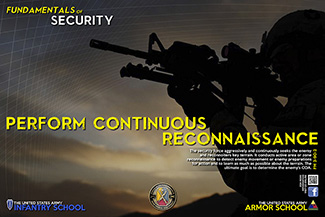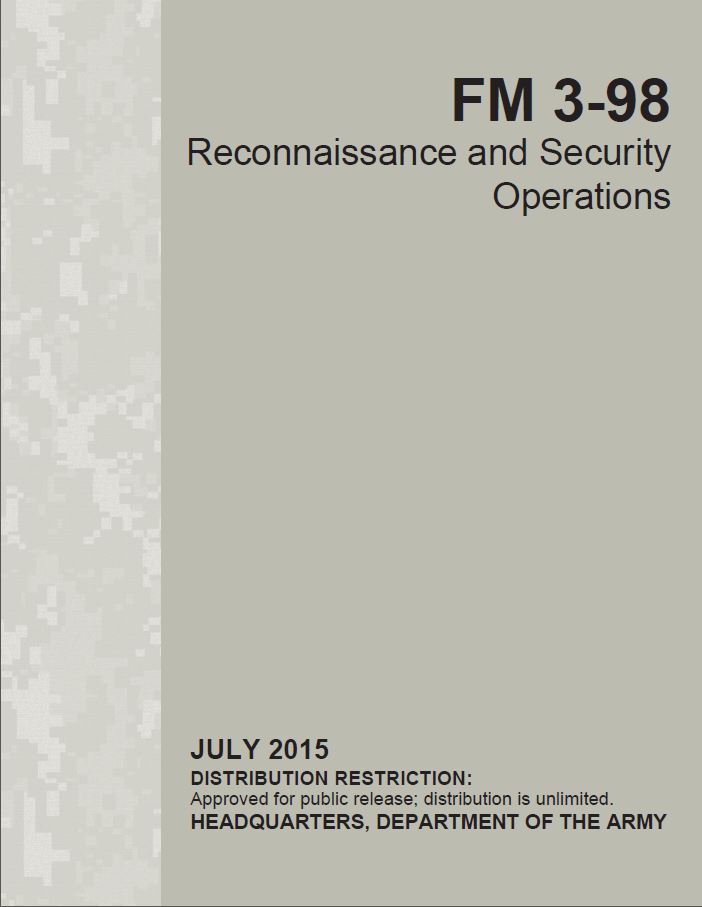PERFORM CONTINUOUS RECONNAISSANCE
The security force aggressively and continuously seeks the enemy and reconnoiters key terrain. It conducts active area or zone reconnaissance to detect enemy movement or enemy preparations for action and to learn as much as possible about the terrain. (In stability-focused operations that terrain includes information on the civil population.) The ultimate goal is to determine the enemy's COA and assist the main body in countering it. Terrain information focuses on its possible use by the enemy or the friendly force, either for offensive or defensive operations. Stationary security forces use combinations of OPs, aviation, patrols, intelligence collection assets, and battle positions (BPs) to perform reconnaissance. Moving security forces perform zone, area, or route reconnaissance along with using OPs and BPs to detect enemy movements and preparations.
The Affray at Slope 30: Perimeter Security
Era: Vietnam
During Operation AKRON in Vietnam in 1967, 3d Squadron of the 11th Armored Cavalry Regiment (Blackhorse), was conducting search and destroy missions in the Viet Cong-controlled HAT-DICH zone. One piece of key terrain in particular, Slope 30, was known to be a common place for VC forces to rest and resupply in the area. Lieutenant Colonel Arthur F. Cochran, the Squadron Commander, broke his unit into four separate teams in order to more effectively conduct missions in the squadron AO (Area of Operations).
On the night of 18 June 1967, Team K was tasked with the defense of the squadron command post and howitzer battery. Team K consisted of three organic platoons with a total of 27 armored cavalry assault vehicles (ACAV), a tank section, and a flamethrower vehicle. The ACAV was an M113 amored personnel carrier armed with a .50 caliber machine gun and two M60 machine guns, all protected by gunshields.
The 30 vehicles formed two rings around the squadron command post. Three ambush patrols of eight to ten men each were sent to the northeast, south, and west between 700-1000 meters out, while listening posts were set up in areas not equipped with anti-intrusion devices.
“The 0100 communications check with the ambush patrols was routine. But, a few minutes later word of the enemy sighting came from an excited radio operator with ambush patrol #1. He reported that enemy contact was imminent. Shortly thereafter, automatic weapons fire and grenade explosions were heard to the northeast. These were followed immediately by violent and intense antitank and automatic weapons fire against the Team K perimeter. Ambush patrol #1 not only gave Team K a few important seconds of warning, but it also prematurely triggered the enemy attack by stopping one of his advancing columns. The ensuing confusion among the enemy ranks in the darkness cost them the element of surprise.” (Captain Ronald A. Hofmann, “A Special Combat Report: The Affray at Slope 30,” Armor, LXXVII, 1 (January-February 1968), p. 15.)
While most of Team K was busy fighting the attack to the northeast, the remaining ambush patrols and listening posts were ordered to stay in place. This proved to be a crucial decision as ambush patrol #3 to the south reported that they were under enemy fire.
“During the action, ambush patrols #2 and #3, as well as the two listening posts, were ordered to remain in position. Radio contact with ambush patrol #1 was lost after their initial warning message just prior to contact. At 0210, ambush patrol #3, 800 meters to the south, reported that it was pinned down by automatic weapons fire and requested assistance. The firing around Team K perimeter began to slow down. Then a six ACAV force under Second Lieutenant Daniel Mullins, the third platoon leader, moved out from the relatively quiet western sector of the perimeter. This force fought its way to the beleaguered patrol #3 and back without any casualties. However, the eight man patrol had suffered three casualties, one dead and two wounded.” (Ibid., p. 17.)
A similar rescue time recovered ambush patrol #1, which had reported and disrupted VC forces moving through their area to attack the main perimeter.
After the battle the American troopers recovered documents showing that the enemy force was a main force battalion of the 274th VC Regiment. Although severely outnumbered and outgunned, Team K was able to defend its position and repel the enemy attack due to its application of security fundamentals. Had the ambush patrols and listening posts not been in place the enemy would have launched a surprise attack directly upon the perimeter, probably causing great loss among the American defenders. The early warning, coupled with firepower and a spirited defense, proved critical to the defeat of a numerically superior VC force.
Fundamentals of Security
- Provide early and accurate warning
- The use of listening posts and ambush patrols effectively alerted Team K to the incoming VC attack
- Provide reaction time and maneuver space
- The listening posts and ambush patrols enabled the Team K leader to effectively employ all available assets to defeat the VC attack
- Orient on the force or facility to be secured
- The forward location of ambush patrols and listening posts between Team K and the attacking VC ensured their orientation upon the main perimeter defense
- Perform continuous reconnaissance
- Throughout the attack, the ambush patrols and listening posts provided information regarding the VC actions, including those areas in which their was no activities, enabling the eventual dispatch of a relief force
- Maintain enemy contact
- The ambush patrols and listening posts retained contact throughout the action. In the case of the ambush patrols, they did so initially through observation and then through direct fire engagement


